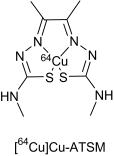Molecular mechanisms of hypoxia in cancer
- PMID: 28596947
- PMCID: PMC5437135
- DOI: 10.1007/s40336-017-0231-1
Molecular mechanisms of hypoxia in cancer
Abstract
Purpose: Hypoxia is a condition of insufficient oxygen to support metabolism which occurs when the vascular supply is interrupted, or when a tumour outgrows its vascular supply. It is a negative prognostic factor due to its association with an aggressive tumour phenotype and therapeutic resistance. This review provides an overview of hypoxia imaging with Positron emission tomography (PET), with an emphasis on the biological relevance, mechanism of action, highlighting advantages, and limitations of the currently available hypoxia radiotracers.
Methods: A comprehensive PubMed literature search was performed, identifying articles relating to biological significance and measurement of hypoxia, MRI methods, and PET imaging of hypoxia in preclinical and clinical settings, up to December 2016.
Results: A variety of approaches have been explored over the years for detecting and monitoring changes in tumour hypoxia, including regional measurements with oxygen electrodes placed under CT guidance, MRI methods that measure either oxygenation or lactate production consequent to hypoxia, different nuclear medicine approaches that utilise imaging agents the accumulation of which is inversely related to oxygen tension, and optical methods. The advantages and disadvantages of these approaches are reviewed, along with individual strategies for validating different imaging methods. PET is the preferred method for imaging tumour hypoxia due to its high specificity and sensitivity to probe physiological processes in vivo, as well as the ability to provide information about intracellular oxygenation levels.
Conclusion: Even though hypoxia could have significant prognostic and predictive value in the clinic, the best method for hypoxia assessment has in our opinion not been realised.
Keywords: Hypoxia; Hypoxia radiotracers; MRI; Positron emission tomography.
Conflict of interest statement
Conflict of interest
The authors, Amarnath Challapalli, Laurence Carroll, and Eric Aboagye declare no conflicts of interest.
Informed consent
This article does not contain any studies with human or animal subjects performed by the any of the authors.
Figures






Similar articles
-
Imaging tumour hypoxia with positron emission tomography.Br J Cancer. 2015 Jan 20;112(2):238-50. doi: 10.1038/bjc.2014.610. Epub 2014 Dec 16. Br J Cancer. 2015. PMID: 25514380 Free PMC article. Review.
-
Molecular imaging of hypoxia.J Nucl Med. 2008 Jun;49 Suppl 2:129S-48S. doi: 10.2967/jnumed.107.045914. J Nucl Med. 2008. PMID: 18523070 Review.
-
More advantages in detecting bone and soft tissue metastases from prostate cancer using 18F-PSMA PET/CT.Hell J Nucl Med. 2019 Jan-Apr;22(1):6-9. doi: 10.1967/s002449910952. Epub 2019 Mar 7. Hell J Nucl Med. 2019. PMID: 30843003
-
Molecular imaging of hypoxia with radiolabelled agents.Eur J Nucl Med Mol Imaging. 2009 Oct;36(10):1674-86. doi: 10.1007/s00259-009-1195-9. Epub 2009 Jun 30. Eur J Nucl Med Mol Imaging. 2009. PMID: 19565239 Free PMC article. Review.
-
Functional brain imaging: an evidence-based analysis.Ont Health Technol Assess Ser. 2006;6(22):1-79. Epub 2006 Dec 1. Ont Health Technol Assess Ser. 2006. PMID: 23074493 Free PMC article.
Cited by
-
Multiplexed Imaging Reveals the Spatial Relationship of the Extracellular Acidity-Targeting pHLIP with Necrosis, Hypoxia, and the Integrin-Targeting cRGD Peptide.Cells. 2022 Nov 4;11(21):3499. doi: 10.3390/cells11213499. Cells. 2022. PMID: 36359894 Free PMC article.
-
Uniform intratumoral distribution of radioactivity produced using two different radioagents, 64Cu-cyclam-RAFT-c(-RGDfK-)4 and 64Cu-ATSM, improves therapeutic efficacy in a small animal tumor model.EJNMMI Res. 2018 Jun 19;8(1):54. doi: 10.1186/s13550-018-0407-3. EJNMMI Res. 2018. PMID: 29923139 Free PMC article.
-
Hypoxia in Lung Cancer Management: A Translational Approach.Cancers (Basel). 2021 Jul 8;13(14):3421. doi: 10.3390/cancers13143421. Cancers (Basel). 2021. PMID: 34298636 Free PMC article. Review.
-
Hypoxia in cervical cancer: from biology to imaging.Clin Transl Imaging. 2017;5(4):373-388. doi: 10.1007/s40336-017-0238-7. Epub 2017 Jul 10. Clin Transl Imaging. 2017. PMID: 28804704 Free PMC article. Review.
-
An overview of the developments and potential applications of 68Ga-labelled PET/CT hypoxia imaging.Ann Nucl Med. 2021 Feb;35(2):148-158. doi: 10.1007/s12149-020-01563-7. Epub 2021 Jan 5. Ann Nucl Med. 2021. PMID: 33400147 Review.
References
Publication types
Grants and funding
LinkOut - more resources
Full Text Sources
Other Literature Sources
